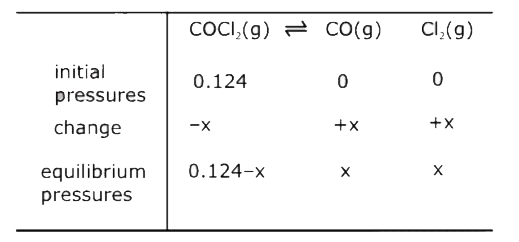Phosgene is a poisonous gas that dissociates at high temperature into two other poisonous gases, carbon monoxide and chlorine. The equilibrium constant Kp= 0.0041 atm at 600K. Find the equilibrium composition of the system after 0.124 atm of COCl2 initially is allowed to reach equilibrium at this temperature.

Substitution of the equilibrium pressures into the equilibrium expression gives
x20.124−x=0.0041
This expression can be rearranged into standard polynomial form x2+0041x–0.00054=0 and solved by the quadratic formula, but we will simply obtain an approximate solution by iteration.
Because the equilibrium constant is small, we know that x will be rather small compared to 0.124, so the above relation can be approximated by
x20.124=0.0041
which gives x=0.025. To see how good this is, substitute this value of x into the denominator of the original equation and solve again:
x20.124−0.0225=x20.102=0.0041
This time, solving for x gives 0.0204. Iterating once more, we get
x20.124−0.0204=x20.104=0.0041
and x = 0.0206 which is sufficiently close to the previous to be considered the final result. The final partial pressures are then 0.104 atm for COCl2, and 0.0206 atm each for CO and Cl2.
Note:
Using the quadratic formula to find the exact solution yields the two roots –0.0247 (which we ignore) and 0.0206, which show that our approximation is quite good. Note: using the quadraticformula to find the exact solution yields the two roots –0.0247 (which we ignore) and 0.0206, which show that our approximation is quite good.
Topper's Solved these Questions
- CHEMICAL EQUILIBRIUMBOOK - MOTIONCHAPTER - CHEMICAL EQUILIBRIUMEXERCISE - SOLVED EXAMPLES
10 Videos
- CHEMICAL EQUILIBRIUMBOOK - MOTIONCHAPTER - CHEMICAL EQUILIBRIUMEXERCISE - Exercise - 1
45 Videos
- CHEMICAL BONDING BOOK - MOTIONCHAPTER - CHEMICAL BONDING EXERCISE - EXERCISE -4 LEVEL-II
40 Videos
- Chemical KineticsBOOK - MOTIONCHAPTER - Chemical KineticsEXERCISE - Exercise - 4 (Level - II) (SUBJECTIVE PROBLEM)
1 Videos
Similar Questions
At a certain temperture in a 5L vessel 2 moles of carbon monoxide and 3 moles of chlorine were allowed to reach equilibrium according to the reaction
CO+CI2→COCI2
at equlibrium if one mole of CO is present then equilibrium constant (kc) for the reaction is :
View SolutionWhat is the equilibrium constantKp and Kc for the reactionPCl5(g)⇔PCl3(g)+Cl2(g) if the pressure is 1.0 atm in 8.0L container at equilibrium.
View Solution
Knowledge Check
Consider the following heterogeneous equilibrium, CaCO3(s)CaO(s)+CO2(g). At 800∘C, the pressure of CO2 is 0.236 atm. The value of Kc for the abvoe given equilibrium reaction at this temperature is
A4×10−5B2.68×10−3C2.64×10−5D1.5×10−3If for the heterogeneous equilibriumCaCO3(s)⇔CaO(s)+CO2(g) , the equilibrium constant Kc=1, at 1 atm what would be the temperature of the reaction?
AT=ΔS∘ΔH∘BT=ΔH∘ΔS∘CT=ΔH∘ΔG∘DT=ΔG∘ΔH∘The equilibrium constant Kp for the thermal dissociation of PCl5 at 200∘C is 1.6 atm. The pressure (in atm) at which it is 50% dissociated at that temperature is
A4.8B4.2C3.2D2.4
For the dissociation reaction
N2O⇔2NO2(g),
the equilibrium constant KP is 0.120 atm at 298K and total pressure of system is 2 atm. Calculate the degree of dissociation of N2O4.
View SolutionA vessel at 1000K contains carbon dioxide with a pressure of 0.5atm. Some of the carbon dioxide is converted to carbon monoxide on addition of graphite. Calculate the value of Kp if total pressure at equilibrium is 0.8atm.
View SolutionFor the reaction C(s)+CO2(g)→2CO(g),kp=63 atm at 100 K. If at equilibrium pCO=10pCO2 then the total pressure of the gases at equilibrium is
View SolutionFor the reaction N2O4(g)⇔2NO2(g), the degree of dissociation at equilibrium is 0.2 at 1 atm pressure. The equilibrium constant Kp will be
View SolutionAmmonium carbamate dissociates on heating as:
NH2COONH4(g)⇔2NH3(g)+CO2(g)
The equilibrium constant Kp for the reaction, at some temperature is 3.2×10−5atm3. Calculate the partial pressure of NH3 in the equilibrium system at the same temperature.
View Solution
